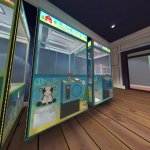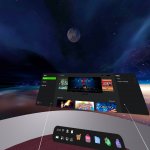Pimax Crystal Standalone Mode & Eye Tracking Impressions
Pimax is holding true to its promises and it is slowly unlocking touted features of its Pimax Crystal VR headset. This week, the company has pushed an update that has updated the Pimax Crystal to support eye-tracking as well as beta Standalone Mode. I’ve had the chance to try these modes in advance of the update and will share my thoughts below.
Pimax Crystal Standalone Mode
One of my personal anticipated features of the Pimax Crystal was the standalone mode as the prospect of immersing myself in a VR environment through the headset’s crisp 8K display was enticing. Pimax even teased the games that would be available, with some being quite promising such as Open Brush, Voxel Fly and Hitstream.
Enabling the Pimax Crystal’s Standalone Mode is as simple as toggling the dedicated switch to the corresponding mode. Even if I tried the beta version of Standalone Mode, my experience was smooth and stable. When it’s powered on, you get to enter a lobby of sorts with an intuitive interface that features a menu that allows you to browse the online games library, install titles that you own and adjust settings.
One downside to the lobby is its bareness. This is likely due to (I hope) the beta version of the Standalone Mode. It would have made for a more welcoming space if you could customise it with items, different colours and background to make it your own VR home.
As for gaming, I tried Pierhead Arcade 2 and X-Fitness. The games work well, with responsive controls and I encountered no connectivity or jittering issues whatsoever. I was pleasantly surprised by the experience considering the beta version and all. The 8K display of the headset further enhanced the experience with crisp, crystal-clear (I had to make that reference!) visuals.
While this is not a review for the games, the ones I’ve tried and what’s currently available on the Pimax Store aren’t as compelling as what you’d find on standalone competitors such as the Meta Quest or Pico. There are obvious comparisons such as X-Fitness being a Beat Saber-like but the offering isn’t on par. So I really hope that Pimax fleshes out its standalone storefront with more compelling titles, especially considering that the Pimax Portal will also share the standalone library with the Pimax Crystal.
For now, the Standalone Mode for the Crystal should be considered as a welcome add-on for the headset rather than the reason you decide to get one. Its main draw is still its stunning display and seamless inside-out tracking for PCVR. But it’s still worth keeping an eye out for developments in this mode, especially with upcoming compatible games.
Pimax Crystal Eye-Tracking
The other feature that was released for the Pimax Crystal is the eye-tracking and this one is not in beta but a full public release. As the name suggests, it uses the headset’s eye-tracking tech to monitor your eye movements to mimic them in-game or for other controls.
I’ve tried it with VRChat and it adds a layer of immersiveness and a sense of presence to your VR avatar that’s not possible with other headsets lacking such a feature. However, activating eye-tracking in VRChat does require going through some hoops but that’s a VRChat issue which other headsets also need to go through. Luckily, Pimax has a comprehensive guide to get it to work with the VR platform.
Aside from in-game eye movement emulation, the Pimax Crystal’s eye-tracking tech from Tobii also features Dynamic Foveated Rendering (DFR) which enables the headset to render only the area you’re looking at. This means less GPU shading load and more computing power that can be allocated to other critical areas; this can in turn lead to boosts in performance and FPS. Pimax has a list of compatible PCVR games with native DFR support.
Another interesting aspect of the eye-tracking is that it can assist with determining the headset user’s IPD (interpupillary distance). Thanks to small motors embedded in the headset, auto-IPD adjusts the lens cups for optimal, personalised visuals. Auto-IPD and DFR are the best use case scenarios for a VR headset that I’ve come across and they work well with the Pimax Crystal.
Developers can further leverage the eye-tracking feature to include another layer of VR input. For example, this can include gaze-based interactions for browsing the menu or for making in-game selections.
Overall, the eye-tracking and standalone features work well and are now available to every Pimax Crystal user, although the latter mode is in beta and I hope to see more customisation options and compatible (and compelling) standalone games. While ideally users should have had access to those promised features from Day 1 of their purchase, it is encouraging to see Pimax hold on to its promises and deliver them. The company has also made a guide to get the popular Switch emulator Yuzu running on the Pimax Portal thanks to the developer Huesos_96, which further shows their commitment to support their devices. I hope to see more such commitment to the Crystal, especially for Standalone Mode.




